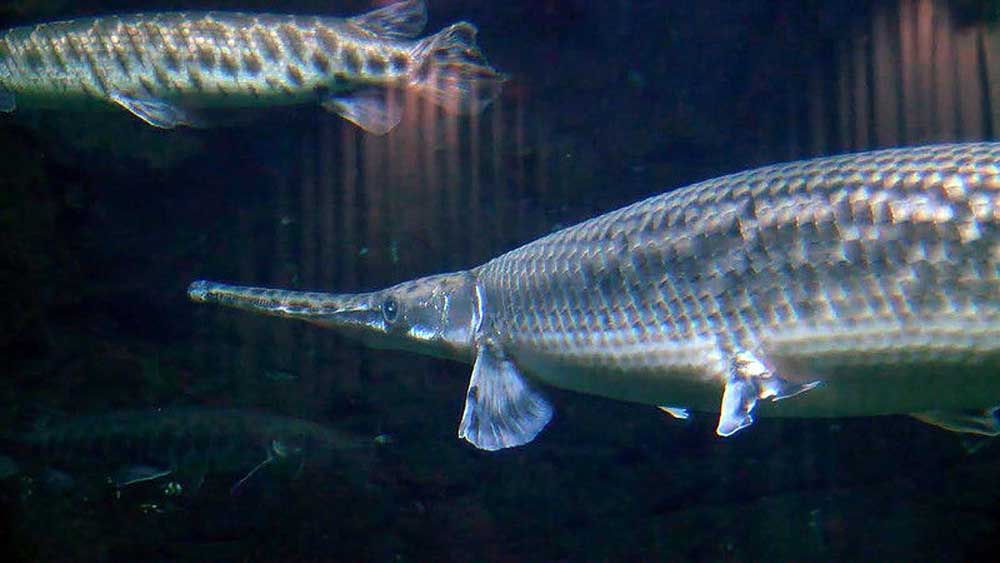Athens facility turns 20 with an eye to the future
Published 7:57 am Monday, November 14, 2016

- TexasAllOutdoors.com ALLIGATOR GAR AND OTHER FISH in the Texas Freshwater Fisheries Center’s dive tank are a big attraction for the facility turning 20 years old this month.
STEVE KNIGHT
outdoor@tylerpaper.com
Trending
ATHENS – It was like moving from a one-room schoolhouse to a state of the art campus when Texas Parks and Wildlife Department moved its fish hatchery operations from the Tyler State Fish hatchery to the Texas Freshwater Fisheries Center.
Built in 1926 and expanded in 1933, the ponds at the old hatchery were sculpted with mule-drawn plows. Still on a per-acre basis it was one of the best bass producing hatcheries in the state system. But it lacked everything including space to grow.
As the original home of the ShareLunker program the Tyler hatcher created the impetus for TPWD to consider adding a visitors’ and education center to its next hatchery facility when more than 9,000 crowded into the tiny hatchery building to see Mark Stevenson’s ShareLunker No. 1, a state record bass weighing 17.67 pounds.
Knowing it could not create such a facility on its budget, the department reached out to cities for a public/private project. Athens was able to write the largest check and in 1996 the TFFC opened, followed two years later by the onsite hatchery operation.
“We have had a great 20 years and we are looking to the future now,” said Mandy Scott, TFFC director. “TFFC is one of the five state freshwater fish hatcheries for the state of Texas. We produce bass, catfish and trout here, but we are also pretty unique because our hatchery has a great visitors’ center.”
The Edwin L. Cox Jr., Visitors’ Center has drawn more than a million visitors since opening.
Trending
One of the features of the center is a lake where visitors can spend time fishing for bass, catfish, bream and trout when in season.
“Over half of those that come are school kids who come in the spring time. We like to have them here, get a fishing pole in their hand and get them excited about fishing,” Scott said.
A self-guided tour of the facility introduces visitors to streams and lakes in Texas. Through aquarium glass they can see what it is like below the water’s surface.
“We have everything from the smallest little pup fish from West Texas to the largest fish in Texas, the alligator gar,” Scott said.
Of course the main attraction remains the center’s indoor dive tank where a diver submerges daily to feed the fish and to explain the different species and answer audience questions.
“One of our specialties is educating the public not just in fisheries but in natural resources education. We have a hunter education course about every month. We also specialize in education programs for the kids. Regular school groups they come here and are educated at the dive show, get a tour, go fishing and talk to naturalists on site,” Scott.
Part of that tour includes a living wetlands trail developed with mitigation money created through the loss of natural wetlands during construction of Athens’ Loop 7.
The hatchery portion of the center is an important cog in the quality of fishing in the state. The hatchery produced just under half of the 8.9 million bass fingerlings stocked in 2015.
“On the hatchery itself we have 45 ponds which is 37 acres of water,” said Tony Owens, hatchery manager. “Our main fish is Florida largemouth bass. We usually raise 4.3 to almost 6 million a year. This year we raised almost 4.4 million, but the quality of the fish was better.”
Owens said the normal criterion is about an inch and a half for bass fingerlings stocked in Texas waters. This year the TFFC consistently sent out fish that were an inch and three-quarters.
“Hopefully that will turn into better survival after they are stocked in the lakes, but we won’t know for a few years,” Owens said.
The fish are stocked throughout the state based on a lake priority list developed by TPWD Inland Fisheries district biologist. Last year’s list was filled with lakes finally recovering from drought conditions.
“They go everywhere. Last year most of our bass deliveries went to West Texas. We drove nearly 29,000 miles just on Florida bass stockings,” Owens said.
After the spring/summer bass season the facility is also tasked with raising 9-inch and larger channel catfish for Neighborhood Fishing Lakes, state park lakes and special events. It is also a holding station in the winter for rainbow trout.
The hatchery may best be known as the home of the Toyota ShareLunker program. Since it opened in 1998 the Lunker Bunker has taken in 287 ShareLunker bass weighing 13 pounds or more from lakes around the state. In the last three years, however, the program has only had 17 entries total.
“The last couple of years have been rough on us. We do everything we can to keep those fish alive. Nothing we do is intentional to harm those fish. We want to get those fish back and spawn them,” Owens said.
This year the program has changed. While everyone catching and reporting ShareLunker bass will be recognized and receive prizes including a mount, only fish caught between January and March will be brought to the hatchery for spawning. Some of the offspring of those that do spawn will be retained as future brood bass for the hatchery system.
Along with changes in the ShareLunker program, changes are also coming to the visitors’ center.
“The next five years we have plans to really do a big upgrade for the whole fisheries center. It starts off with alligator exhibit,” Scott said. “We are about to reopen the alligator exhibit with new features and bringing the gators back in about a week and that won’t be the end of it.
“We are planning on upgrading many of our exhibits and have a whole new fresh look to our visitors’ center for the 25th anniversary.”
For more information on the TFFC, go online to https://tpwd.texas.gov/spdest/visitorcenters/tffc/.






